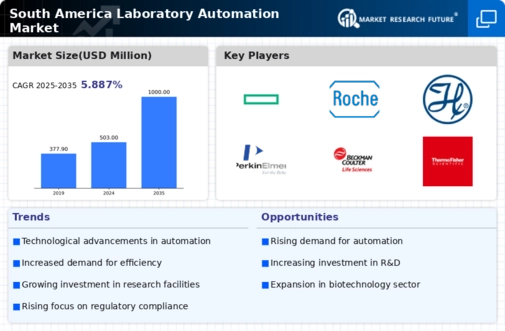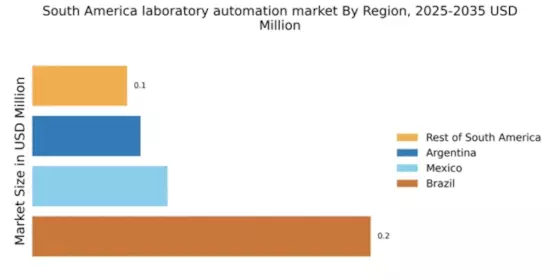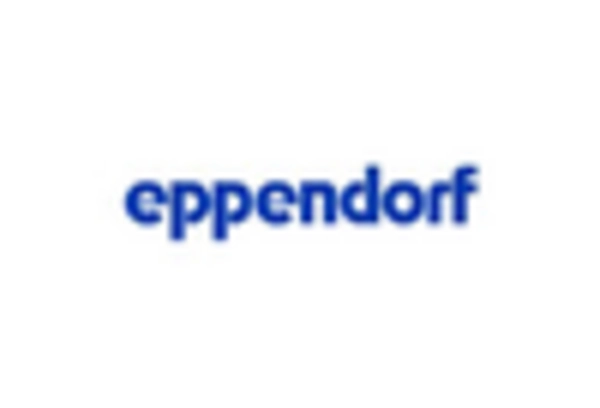Emphasis on Cost Reduction and Efficiency
In South America, the laboratory automation market is witnessing a strong emphasis on cost reduction and operational efficiency. Laboratories are increasingly seeking ways to minimize operational costs while maximizing productivity. Automation technologies offer solutions that streamline workflows, reduce manual errors, and enhance throughput, thereby contributing to overall cost savings. As competition intensifies in various sectors, including healthcare and research, organizations are compelled to adopt automated systems to remain competitive. The potential for significant cost reductions, estimated at around 20% in some cases, is driving the adoption of laboratory automation solutions. This focus on efficiency not only benefits individual laboratories but also has broader implications for the industry, as it encourages the development of more innovative and cost-effective automation technologies.
Rising Demand for High-Throughput Screening
The laboratory automation market in South America is experiencing a notable increase in demand for high-throughput screening technologies. This trend is driven by the need for rapid and efficient testing in various sectors, including pharmaceuticals and biotechnology. As research institutions and companies strive to accelerate drug discovery processes, the adoption of automated systems that can handle large volumes of samples is becoming essential. Reports indicate that the market for high-throughput screening in South America is projected to grow at a CAGR of approximately 12% over the next five years. This growth reflects the increasing investment in research and development, as well as the need for improved accuracy and reproducibility in laboratory results. Consequently, the rising demand for high-throughput screening is a significant driver in the laboratory automation market, influencing technology development and market dynamics.
Increasing Focus on Data Integrity and Security
The laboratory automation market in South America is increasingly characterized by a focus on data integrity and security. As laboratories adopt more automated systems, the need to ensure the accuracy and security of data becomes paramount. Regulatory bodies are placing greater emphasis on data integrity, necessitating the implementation of robust systems that can safeguard sensitive information. This trend is particularly relevant in sectors such as pharmaceuticals and clinical research, where data accuracy is critical for compliance and decision-making. The laboratory automation market is responding to this demand by developing solutions that incorporate advanced security features and data management capabilities. As a result, the market is expected to grow at a rate of approximately 8% annually, driven by the increasing need for reliable and secure laboratory data management.
Growing Investment in Biotechnology and Pharmaceutical Research
The laboratory automation market in South America is significantly influenced by the growing investment in biotechnology and pharmaceutical research. Governments and private entities are increasingly allocating funds to enhance research capabilities, which in turn drives the demand for automated laboratory solutions. This investment is aimed at fostering innovation and improving healthcare outcomes, particularly in regions where access to advanced medical treatments is limited. As a result, the laboratory automation market is expected to expand, with projections indicating a growth rate of approximately 15% over the next few years. This surge in investment not only supports the development of new technologies but also encourages collaboration between research institutions and industry players, further propelling the laboratory automation market forward.
Advancements in Laboratory Information Management Systems (LIMS)
Advancements in Laboratory Information Management Systems (LIMS) are playing a crucial role in shaping the laboratory automation market in South America. These systems facilitate the efficient management of samples, associated data, and laboratory workflows, thereby enhancing productivity and compliance. The integration of LIMS with automated laboratory equipment allows for seamless data transfer and real-time monitoring, which is vital for maintaining quality standards. As regulatory requirements become more stringent, laboratories are increasingly adopting LIMS to ensure compliance and improve operational efficiency. The market for LIMS in South America is expected to witness a growth rate of around 10% annually, driven by the need for better data management and traceability in laboratory processes. This trend underscores the importance of LIMS in the laboratory automation market, as it supports laboratories in optimizing their operations and meeting regulatory demands.


















Leave a Comment